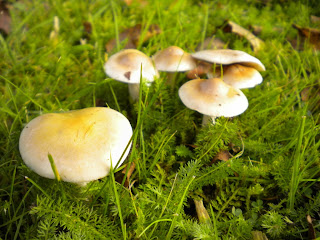 Weathermen; you just can't trust em! Those of us daft enough not to take waterproof trousers , got a little bit damp. Showers aside, it was a productive day and with lots of different fungi out in great numbers, it was worth the odd downfall.
Weathermen; you just can't trust em! Those of us daft enough not to take waterproof trousers , got a little bit damp. Showers aside, it was a productive day and with lots of different fungi out in great numbers, it was worth the odd downfall.Russulas were out, a purple variety and Russula ochreleuca/Ochre Brittlegill, which has been consistently fruiting here on Kilvey for at least, three months. I've seen so many r. ochreleuca now that I'm almost blind to them but occasionally I find one that is stunning. I'm also taken by the length of the fruiting season for this russula as well as the quantity.
Lactaria/Milkcaps were about in force too. I wonder if the stretch of ground where we found so many fungi, which has constantly produced fruitbodies from the same species for weeks on end, is significant. There is one very important thing about this place: No one walks there!
There were plenty on brow-furrowing cortinarius for me to frown at and nicer things like the bolete family: especially leccinum and suillus.
Other good finds were Tricholoma equestre/Yellow Knight, Pluteus cervinus/Deer Shield, Collybia maculata/Spotted Toughshank.
There were a variety of Lycoperdon/Puffballs, even a jelly fungi. We found only one bracket.
I've included some lichen, along side one of the most bizarrely coloured mushrooms I've ever seen.
Finally, there was an orange-yellow mushroom fruiting on wood. It was growing everywhere, We found it in huge numbers. I admit, I didn't have a clue as to what it was, but that frustration will make me find out.







Collybia maculata/Spotted Toughshank







Pluteus cervinus/Deer Shield






Tricholoma equestre/Yellow Knight

 On the left is Mycena pura/Lilac Bonnet, the right: Suillus grevellei/Larch Bolete. This young suillus was identified by Phil and there were older fruitbodies around, (photo above).
On the left is Mycena pura/Lilac Bonnet, the right: Suillus grevellei/Larch Bolete. This young suillus was identified by Phil and there were older fruitbodies around, (photo above).Many of this group (of bolete relations) have rings and a glutenous cap. The veil remnant on the stalk can be seen.
This suillus has a distinct light edge around the edge of the cap and
when the fruitbody is mature, the pore openings look sponge-like, with irregular shaped openings. The entire cap has a spongey texture that resists slicing.
Most boletes have a cylindical tube structure: slice through the cap to be sure.













































